Baccarat Books
A Brief History of Baccarat
Despite being one of the most widely played and beloved casino games ever conceived, baccarat is a game with historical roots which are still shrouded in mystery.
Similarly constructed games involving many shared concepts but lacking the element of playing cards have been recorded in antiquity. The ancient Romans, for example, held ceremonies for vestal virgins, who were required to roll a nine-sided die. As the objective for this ritual was to roll either an 8 or a 9, thus making the virgin eligible for a high priestess position, gaming historians widely believe it to be one of the earliest known precursors to modern baccarat.
Alternate Baccarat Origins
As is usually the case when assessing historical accuracy, however, competing theories regarding baccarat’s origins have also been developed. For example, a game known as Macao was played in Italy during the 18th century, requiring players to reach the total closest to nine to win each hand. A wider family of related card games, one which includes blackjack, pontoon, vingt-et-un, and several other fixed number card game variations common to cultures all over the planet. The game of vingt-et-un takes its name from the French word for the number 21, but it actually shares more commonalities with baccarat than it does blackjack.
The most commonly cited source for baccarat’s invention comes from the manuscripts of French author Charles Van-Tenac, who wrote his “Album des Jeux” in 1847. This “Album of Games” included a mathematical analysis of a card game known as baccarat spread over 13 pages, and the consensus among historians is that Tenac’s research represents the first written documentation of baccarat as we know it today.
France is also home to another ancestor of baccarat, a game known as chemin de fer which translates to “the iron way” in English. This term derived from the iron card holder used to house decks during games of chemin de fer. As a non-banking form of baccarat, chemin de fer requires players to alternate between turns playing the “banker” position. Chemin de fer survives today, and the game is still the preferred baccarat variant in its native country.
Punto Banco is Created
![]() During the 19th century, Europeans also developed a game known as punto banco, a banker based game that forms the foundation for baccarat as we know it today. With “punto” translating to the punter, or player, and “banco” meaning banker, the connections between both games are apparent. In punto banco, players place wagers against the house banker, which has been the primary way to play baccarat ever since.
During the 19th century, Europeans also developed a game known as punto banco, a banker based game that forms the foundation for baccarat as we know it today. With “punto” translating to the punter, or player, and “banco” meaning banker, the connections between both games are apparent. In punto banco, players place wagers against the house banker, which has been the primary way to play baccarat ever since.
By 1911, the seminal manual on games of chance and skill, Official Rules of Card Games: Hoyle Up to Date covered the games of chemin de fer and punto banco, with the latter referred to as baccarat. Most historians trace baccarat’s arrival in America to around this time as well, but anecdotal evidence suggests that the game had been played in the United States as early as 1871.
Modernized by Sands Las Vegas
It wasn’t until 1958 that chemin de fer first appeared at The Sands in Las Vegas, but local players were less than enthused about the foreign-sounding game. One year later, however, and both Nevadans and tourists soon began taking to baccarat in droves. American gambler and casino executive Tommy Renzoni learned the game while visiting Havana, Cuba, and he brought baccarat back with him to the states.
When Renzoni launched a promotion at The Sands on November 20th, 1959 the first baccarat games ever played in Sin City commenced in earnest. From that point forward, the game became a staple of pop culture, appearing in now legendary James Bond scenes among many others, and today baccarat is one of the most widely played casino games in all the world.
Baccarat Literature
![]() When the cottage industry of casino game strategy content emerged during the 1970s and 1980s, baccarat was initially given short shrift by theorists and experts. The impression was that such a simple game of chance couldn’t possibly contain the layers of strategic elements needed to form a working optimal strategy, card counting methods, or other avenues of overcoming the already low house edges of 1.06 percent on banker bets and 1.24 percent on player bets.
When the cottage industry of casino game strategy content emerged during the 1970s and 1980s, baccarat was initially given short shrift by theorists and experts. The impression was that such a simple game of chance couldn’t possibly contain the layers of strategic elements needed to form a working optimal strategy, card counting methods, or other avenues of overcoming the already low house edges of 1.06 percent on banker bets and 1.24 percent on player bets.
Eventually, though, casino game theory began to catch up with baccarat, and a few titles analyzing the game were added to the industry’s library. While most of these books attempt to translate the undeniable success and effectiveness of card counting in blackjack to another game involving playing cards and set numbers, this approach is disingenuous at best. A statistical study of baccarat’s underlying probabilities, conducted with the aid of modern computing technology, has consistently demonstrated that counting cards, while possible, doesn’t result in the same mitigation of the house edge enjoyed by advantage play blackjack specialists.
Simply put, card counting and other systems designed to “beat” baccarat are ineffective at best, and complete nonsense at worst. Even with an accurate count through the shoe, studies have shown that baccarat players simply can’t gain enough of an edge to result in long-term increases to their expected value. By the time a counter has identified optimal situations to increase their bets, the shoe contains so little cards that only a few attempts at extracting value can be made.
With these facts in mind, many baccarat books promising fallacious “foolproof” or “surefire” ways to win do manage to contain helpful instructional guides for beginners, colorful anecdotes from the glory days of the road gamblers, and sound advice on money management and disciplined play.
Below, you’ll find a list of widely read books on baccarat, in chronological order, along with biographical information for the author and an objective review of the content.
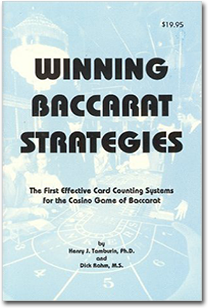
Winning Baccarat Strategies: The First Effective Card Counting Systems for the Casino Game of Baccarat
Henry Tamburin & Dick Rahm (1983)
As a mathematician who holds a Ph.D. in chemistry, the scholarly Henry Tamburin has led a double life of sorts, moonlighting as an advantage play blackjack specialist and casino game theorist for more than 50 years.
An avid strategist, Tamburin has contributed over 700 articles on game theory and optimal play to a long list of industry publications, including The Gambler Magazine, Gaming South Magazine, Strictly Slots, and Casino Player Magazine.
In 1994, Tamburin’s Blackjack: Take the Money and Run became a best-selling gambling book, and he has seven titles to his credit covering several casino games. But for Tamburin, his career as a game theorist began in 1983 with the publication of a slim 87-page manual on baccarat titled Winning Baccarat Strategies: The First Effective Card Counting Systems for the Casino Game of Baccarat.
In writing one of the first advanced strategy primers for baccarat, Tamburin and his co-author Dick Rahm skip right over the game’s basics and move directly to high-level mathematics, probabilities, and of course, card counting techniques. Fortunately for readers, while the studious Tamburin does his due diligence by investigating the effectiveness of card counting, he accurately determines the practice to be relatively useless. Calculating an expected return of less than one dollar per hour derived from the mentally taxing and potentially illicit activity, Tamburin concludes that counting cards in baccarat is simply not worth the reader’s time.
Along with a standard set of progressive betting systems designed to reduce variance, Tamburin also includes an unintentionally humorous section on using extrasensory perception (ESP) as a method of winning more often. Knowing Tamburin’s background, this recommendation is more than likely given with tongue planted firmly in cheek, but readers may be taken aback by the suggestion nonetheless.
Tamburin’s Winning Baccarat Strategies still contains useful information on comprehending the game’s finer point, and the book is best enjoyed when paired with another title written expressly for beginners.
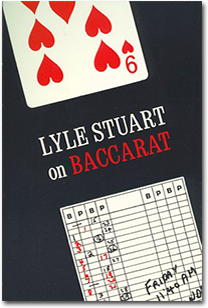
Lyle Stuart on Baccarat
Lyle Stuart (1984)
During his long life Lyle Stuart earned a reputation as a “renegade publisher,” and his willingness to put any title imaginable into print often caused controversy.
Stuart was born in 1922 as Lionel Simon in New York City, dropping out of high school and marrying at the age of 22. Rampant antisemitism at the time compelled Simon to adopt the Americanized “Lyle Stuart” moniker, and he began a career as a small-time journalist and tabloid publisher.
A media feud with Walter Winchell, newspaperman and fellow purveyor of gossip and rumor, garnered Stuart a certain level of notoriety during the 1940s and 1950s. Eventually, a successful libel lawsuit filed by Stuart netted the necessary funding for a new publishing house, and Lyle Stuart Inc. was born. The company specialized in printing taboo titles, like History Will Absolve Me (1961), a communist manifesto penned by Fidel Castro at the height of the Cold War.
A string of successful releases, including The Rich and the Super-Rich (1968), The Sensuous Woman (1969) and Jackie Oh! (1978), transformed Stuart into a multimillionaire. He continued to court controversy, however, publishing The Anarchist’s Cookbook – a guide to building homemade explosives and other terrorist activities – in 1978.
Stuart used his new fortune to acquire an ownership stake in The Aladdin, one of the first major casino resorts to spring up on the Las Vegas Strip. Over time, he began applying his insider knowledge of the gaming industry to a new line of casino strategy manuals. After beginning with Casino Gambling for the Winner in 1978, Lyle Stuart on Baccarat followed in 1984. A reprint was commissioned in 1997, containing all of the same information as the original, but updating a few sections to reflect the current casino climate and new baccarat variations.
The book clocks in at over 300 pages, and as a storyteller by trade, much of the content consists of a colorful recounting of baccarat history, with Stuart diving deep into the Cuban casino scene and other interesting tangents. The casino owner also includes several anecdotes from Las Vegas’ earlier era, and these historical nonfiction elements make the book a tremendous read on their own.
Of course, Stuart also delves into the rules, gameplay structure, and wagering for beginning baccarat players. When it comes to strategy advice, Stuart attempts to play both sides of the fence, first advising readers that no effective system for beating baccarat, overcoming the house edge, or counting cards have ever been successfully developed. At multiple junctures in the book, Stuart makes sure to explain that the system approach to games of chance like baccarat is invariably made up of snake oil.
And yet, Stuart devotes several pages to his “Rule of Three,” or a simple set of guidelines designed tell players when to bet on so-called streaks:
“The Rule of Three says you either bet on the streak, or you don’t bet at all… If you bet with the streak and you’re wrong, you lose only one wager. If you bet against it and are stubborn, the casino will soon own your potato farm.”
To be sure, limiting your betting to a single wager “with” the streak, rather than multiple wagers “against” it, will limit your losses over the long run. But as any sophisticated gambler knows well, the concept of streaks simply doesn’t hold water, and despite what you might observe in short-term data sets and small sample sizes, every deal represents a wholly independent occurrence.
Stuart also includes a wealth of information on baccarat tournaments among his long line of entertaining stories. For readers with an interest in the way things once were, Stuart’s book should provide hours of reading and a true glimpse back to a bygone era. Advanced baccarat players hoping to improve their game will also benefit from Stuart’s cut and dry advice on the fallacy of systems, and his effective (if a bit misguided) theories on managing your bets.
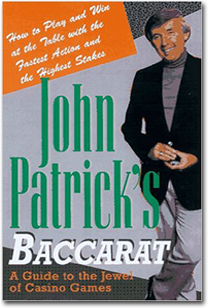
John Patrick’s Baccarat: A Guide to the Jewel of Casino Games
John Patrick (1985)
With over 50 years of experience as a professional gambler and casino games expert, John Patrick has definitely been there and done that.
As a regular on the riverboat casino scene which sprang up along the Mississippi River during the 1960s, Patrick tried to live the dream and support himself by playing cards and betting sports. Unfortunately for him, the realities of the house edge soon caught up with Patrick, and he eventually went broke. After taking a job as a casino “prop player,” earning $10 per day while keeping the tables filled for the tourists, Patrick began taking the job more seriously. As he gradually accumulated a new bankroll, Patrick also worked on ways to limit his losses, hoping to never again be reduced to punching the clock.
With a renewed determination to preserve his bankroll at all costs, Patrick developed his own system of money management, one designed to secure small wins while avoiding disastrous defeats. Asked about his approach to playing casino games in search of modest, yet consistent, profit, Patrick once said “I don’t win a lot, but more importantly, I don’t lose a lot. I know what it’s like to lose because I was so good at it. It ain’t a good feeling.”
As the author of several casino gambling strategy books, many under his So You Wanna Be a Gambler? series, Patrick has compiled his knowledge in titles like “Blackjack” (1983) and “Slots-Roulette” (1983). He also hosted the “So You Wanna Be a Gambler?” weekly television show on Financial News Network (FNN), answering questions directly from viewers for over 10 years.
With the release of John Patrick’s Baccarat: A Guide to the Jewel of Casino Games, Patrick applies the same “So You Wanna Be a Gambler?” approach to baccarat. This means readers can expect to find a heavy dose of money management rules and advice on staying disciplined throughout the book’s 256 pages. Much of this information is premised around Patrick’s “Big Four” structure, which covers the concepts of Bankroll, Knowledge, Money Management and Discipline.
While the book was originally published in 1985, an updated version was released in 1997 to better reflect the current casino environment. Unfortunately, for Patrick, while the study of baccarat game theory has indeed evolved, the author has remained decidedly stuck in the past. To get things off on the wrong foot, the updated version begins with a section titled “Introduction to Craps,” obviously a lazy misprint which likely occurred as Patrick copy and pasted his “So You Wanna Be a Gambler?” pitch from one document to another. Patrick’s tone is also quite grating, as he alternates between a gruff old gambler persona and know it all style.
Overall, John Patrick’s Baccarat offers decent information on the game’s basics, including rules, gameplay structure, and available wagers, so beginners will be able to learn the ropes. Furthermore, rather than offer convoluted and unproven systems designed to beat the house, Patrick devotes much of his time to the concept of patient play, sound money management, and disciplined deployment of your bankroll.
But as many reader-generated reviews have noted, Patrick is simply rehashing old information which has been previously presented in other books. If you’ve ever read a “John Patrick’s” gambling title, you already know the money management advice offered in this baccarat entry, so more comprehensive options should be considered first.
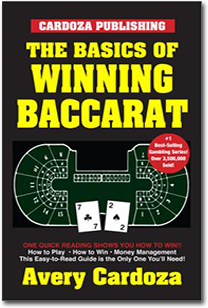
Basics of Winning Baccarat
Avery Cardoza (1992)
As an underage advantage play gambler plying his trade in Las Vegas during the 1970s, a young Avery Cardoza specialized in counting cards as a professional blackjack player. But even as he reduced his risk to essentially zero at the tables, Cardoza was still pressing his luck.
It didn’t take long for the skilled counter to attract attention from casino security, and in 1981 Cardoza was officially barred from playing in Nevada casinos altogether. As a member of the infamous “blacklist,” Cardoza was soon persona non grata in the casinos of surrounding states as well, having become too recognizable as a proficient advantage player. In search of an alternative source of income, and intent on sharing his accumulated knowledge with others, he founded Cardoza Publishing that year.
Beginning with Winning Casino Blackjack for the Non-Counter (1981) and Casino Craps for the Winner (1984), Cardoza has personally authored dozens of titles on casino game strategy, while publishing hundreds of others from the talented roster of Cardoza Publishing resident experts.
With his seventh book and first on baccarat, Cardoza’s “Basics of Winning Baccarat” is short and sweet at just 64 pages. Over the course of 10 chapters, the author provides readers with a clear and concise introduction to the rules of baccarat, the game’s unique vernacular, the “player” and “banker” positions, available wagers and associated odds for each, and the commonly encountered variations.
Cardoza discusses the crucial differences between American baccarat, Chemin de Fer, baccarat banque, and mini-baccarat, setting readers up with a broad but basic understanding of multiple versions of traditional baccarat.
Players in search of strategic advice will have to look elsewhere, though, as Cardoza stays true to the book’s title and covers only baccarat basics. Ever the savvy publisher, he’s simply setting readers up for a second purchase, hoping they’ll enjoy baccarat enough to buy The Baccarat Master Card Counter (2003).
With this much more expensive entry, Cardoza compiles a supposedly copyrighted strategy for counting through the deck in baccarat. The usual suspects like the running count, the true count, and deck favorability are explored in depth, and Cardoza promises readers a “scientific way to win.” However, with the effectiveness of baccarat counting systems under heavy scrutiny by well-known mathematically inclined casino game experts, the information found in The Baccarat Master Card Counter should not be considered accurate or useful in the modern casino setting.
On the other hand, Basics of Winning Baccarat (which was reprinted in 2003 and 2011) offers readers a solid foundation in terms of the game’s technical aspects, and beginners will surely benefit from the brisk read.
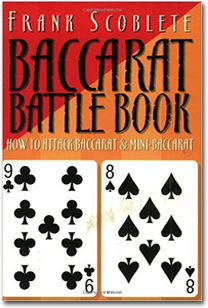
The Baccarat Battle Book
Frank Scoblete (1995)
Touring the Eastern seaboard as a theater actor and entertainer, Frank Scoblete experienced an epiphany in 1985 while researching a role for an upcoming play called “The Only Game in Town.”
On a visit to Atlantic City, New Jersey’s then thriving casino scene, Scoblete, and his co-star Alene Paone became enamored with the idea of beating the house at its own game. Scoblete sold off his shares in the theater company, and with his wife to be Paone at his side, the pair began earning their living from casino games as aspiring advantage players. Throughout the 1980s, Scoblete also wrote articles on game theory and strategy for publications like WIN Magazine, which prompted him to form his own publishing house and write his first full-length book Beat the Craps Out of the Casinos in 1991.
Over the next decade Scoblete authored books on blackjack, roulette, slot machines, video poker and even niche games like Spanish 21, Caribbean Stud, and Let It Ride, but The Baccarat Battle Book was the first to cover the classic card game. And even though the book spans 214 pages, relatively lengthy by industry standards, it’s obvious why Scoblete covered seemingly every other game on the floor before turning his attention to baccarat.
As an author, Scoblete is prolific but not always accurate when it comes to content. Part of his continued popularity among casual casino game enthusiasts is the way in which Scoblete writes with an evident passion for most subjects. Unfortunately, that love for the game simply doesn’t translate to The Baccarat Battle Book, and readers familiar with Scoblete’s work will recognize his lack of genuine interest. As he himself admits, trips to the baccarat tables are research trips only and are seldom if ever motivated by a personal desire to play. This conflict makes the book read more like an obligation he fulfilled, simply scratching the last game off a list and adding to his library as a casino game expert.
With that said, Scoblete offers his typically astute understanding of both baccarat basics and the game’s complexities. Readers interested in expanding their baccarat knowledge can learn about money management techniques and ways to prolong the playing experience by mitigating volatility and variance. In particular, the section on reducing the commission on winning banker bets from 5 percent to 4 percent could prove to be especially useful over the long run.
For beginners looking for an approachable entry point to baccarat, and intermediate players searching for ways to sharpen their skills, The Baccarat Battle Book is a serviceable, if uninspired, read. The advanced player, on the other hand, shouldn’t expect to find much here in the way of new territory or groundbreaking insight.
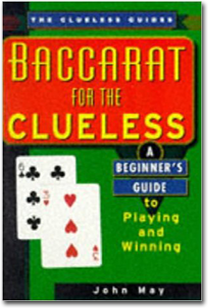
Baccarat for the Clueless
John May (1998)
For nearly two decades, John May has studied and written about casino game theory.
With dozens of articles to his credit since 1999, the Irish-born author has also published two books on casino game strategy: Baccarat for the Clueless (1998) and Get the Edge on Blackjack (2000). With the former, May applies his preferred approach to advantage play to baccarat, having already perfected his craft as a professional blackjack player for a number of years.
The first section of the 144-page Baccarat for the Clueless is exactly that, and May walks novices through the essential information they’ll need to know before placing their first wager. For those who are new to baccarat, the information contained here should be considered required reading. Indeed, May’s book is considered by many to be the most effective instructional guide on the market. May also explores several popular baccarat strategies employed by professional players, describing the methodology before offering his own appraisal as to their effectiveness.
The second section of the book is dedicated to applying May’s extensive knowledge of blackjack strategy to baccarat. For readers unfamiliar with blackjack terminology, this rhetorical strategy may not be preferable, as May relies heavily on relating strategic advice on baccarat to blackjack. But for experienced blackjack players, this actually may be the best way to grasp the book’s fundamental lessons.
May’s instruction straddles both sides of the fence, as he flatly (and accurately) advises readers that progressive betting systems don’t work as advertised while also devoting an entire chapter to the disproven technique of card counting through a baccarat deck. Whether you’ll find these pages enjoyable or irrelevant depends entirely on your personal philosophy regarding the efficacy of card counting for baccarat.

Secrets of Winning Baccarat
Brian D. Kayser (2003)
Little is known about Brian D. Kayser, other than that he hails from a background in mathematics.
You wouldn’t know that to be true after reading Secrets of Winning Baccarat, wherein Kayser falls prey to one of the most basic errors in all of the statistics: insufficient sample size. Kayser’s findings are based on his recording and analysis of every hand from 232 shoes’ worth of baccarat. Unfortunately, while the author attempts to impress readers with complex mathematical formulas and obscure terminology, even undergraduate statistics students know that a sample size of 232 shoes is not nearly large enough to offer a true reflection of the game’s probabilities.
This fatal error makes the entirety of Kayser’s strategic advice null and void, as his conclusions are based on faulty data. Furthermore, he completely neglects to mention the importance of the five percent commission.
Throughout the book’s 257 pages, the most accurate assessment of baccarat strategy offered by Kayser concerns the dubious validity of advice like this:
“If there were some magical ‘system’ to winning at baccarat, no one in his right mind would write a book and tell you about it. He’d just keep it to himself and get rich.”
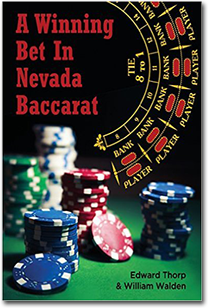
A Winning Bet in Nevada Baccarat
Edward Thorp & William Walden (2013)
Edward O. Thorp became one of the original casino game theorists in 1962, with the publication of his landmark blackjack book Beat the Dealer.
After discovering the research on blackjack’s optimal strategy conducted by a team of mathematicians better known as the “Four Horsemen” today, Thorp became intrigued by the idea of nullifying the house’s omnipresent edge. While working as a professor at the Massachusetts Institute of Technology (MIT), and later New Mexico State University, Thorp ran data analysis through an IBM 704 computer, hoping to assess the impact of tracking exposed cards during blackjack on the game’s basic odds and probabilities.
Thorp incorporated and expanded upon the pioneering research conducted by the Four Horsemen, while also applying an optimal betting pattern theory known as the Kelly Criterion, to conceive an optimal strategy for blackjack which makes use of card counting techniques. In doing so, Thorp created the “ten-count system,” the forerunner to the “hi/low” counting system utilized by advantage players ever since.
In 1964 Thorp, working alongside William Walden co-authored a paper on baccarat strategy titled “A Favorable Side Bet in Nevada Baccarat,” which was published in the Journal of the American Statistical Association (Vol 61, No. 314) in 1966. Essentially, the paper contained detailed statistical analysis on the probabilities associated with two common side bets of the era. As Thorp and Walden described these side bets:
“One can bet that The Banker has a natural 9. One can also bet that The Banker has a natural eight. These same bets can sometimes also be made with respect to The Player. The side bets each pay 9 to 1 (equivalently, 10 for 1). For eight complete decks, the probability of a natural nine is 0.09490, a house advantage of 5.10 per cent. For eight complete decks, the probability of a natural eight is 0.09453, a house advantage of 5.47 per cent.”
Unfortunately, for modern readers, while Thorp did indeed take advantage of these side bets to earn consistent profits during his in-casino trials, these side bets simply don’t exist any longer.
With the 82-page book “A Winning Bet in Nevada Baccarat” Thorp has done nothing more than repackaging his original paper for resale. The contents of the book are simply the paper itself, along with a brief introduction. The paper, which can be accessed online through scholarly research databases, is a historical artifact but offers nothing for baccarat players today.






